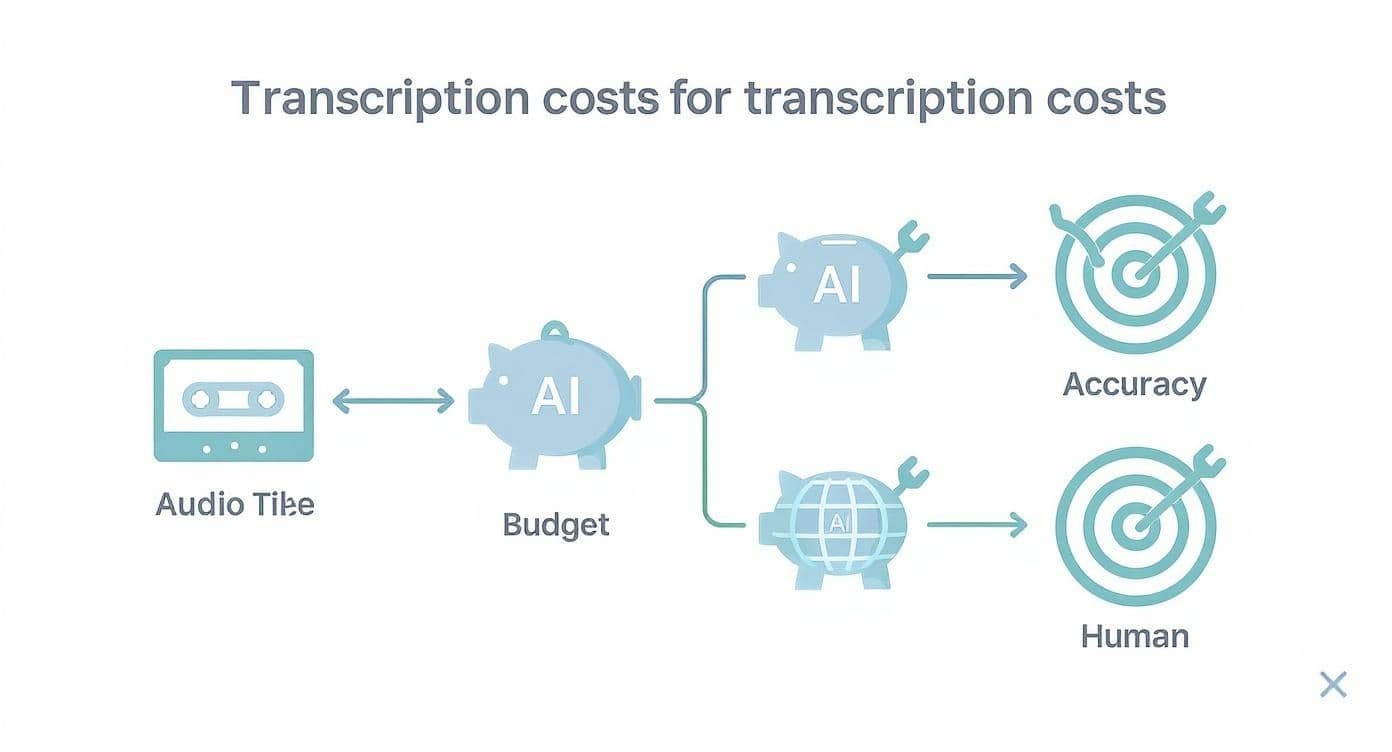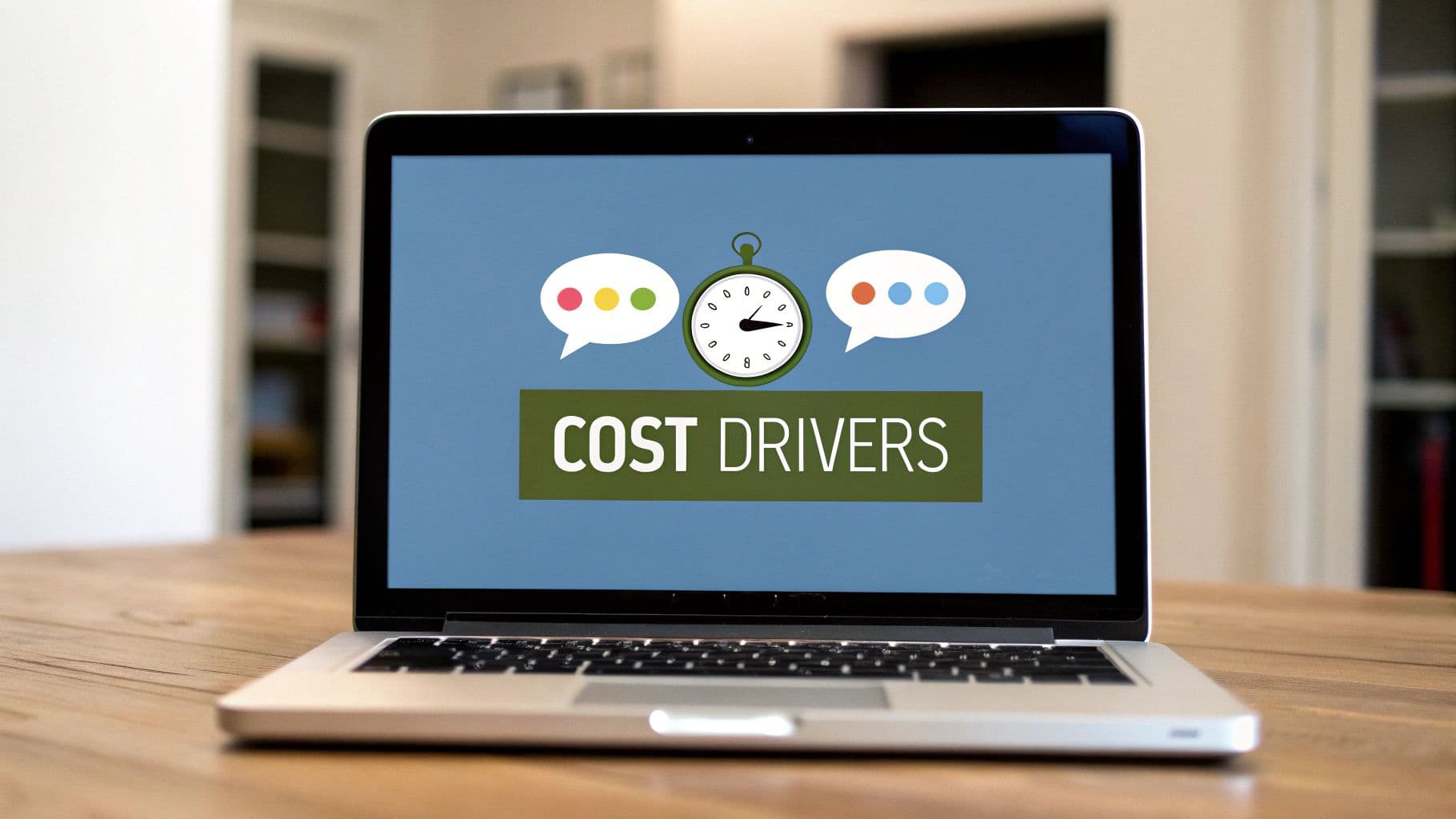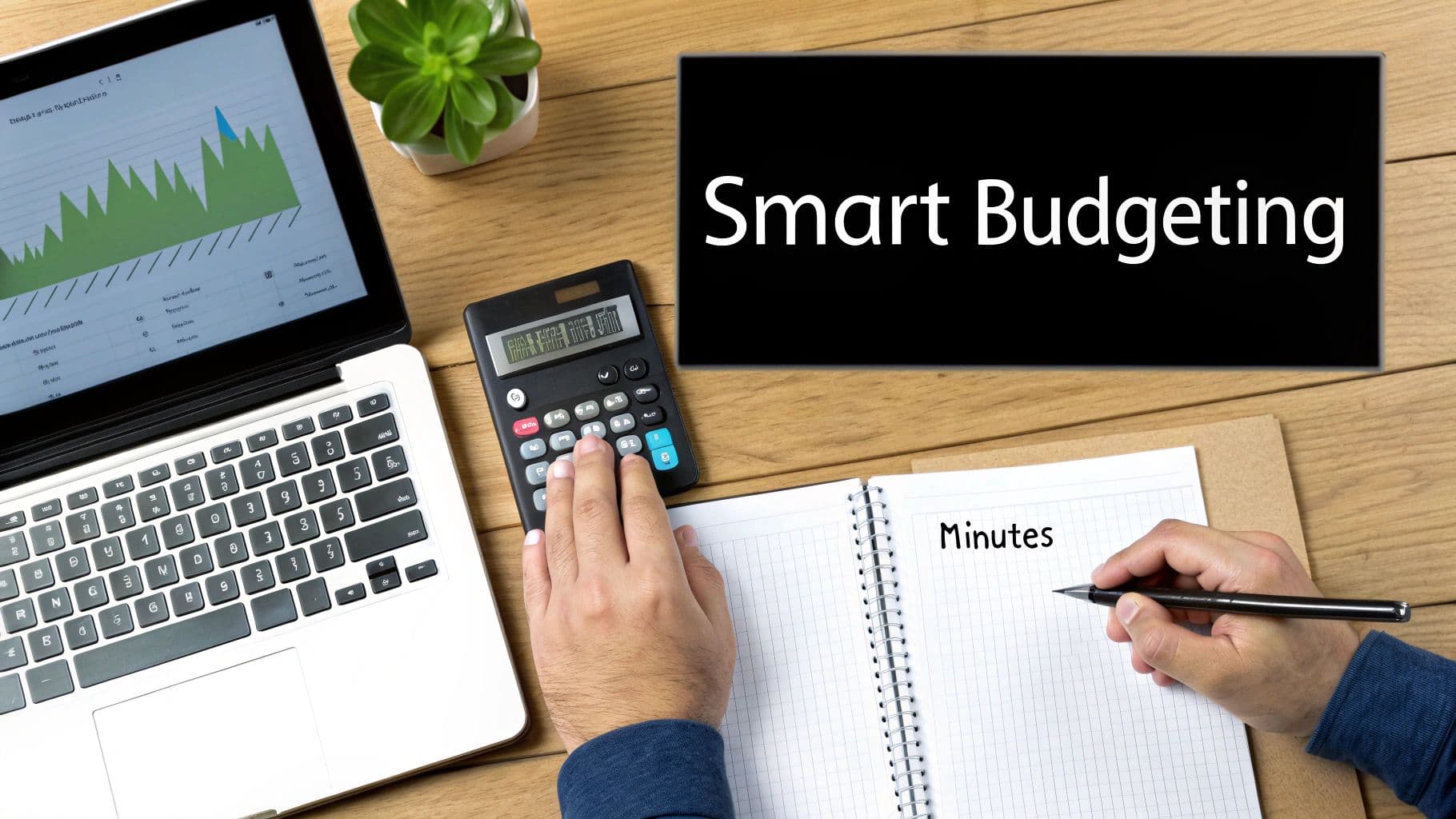Transcription services can cost you anywhere from 0.07 a minute for an AI tool** all the way up to **3.00 or more per minute for a professional human transcriber. What you end up paying really boils down to one simple question: do you need it cheap and fast, or do you need it to be perfect?
Your Quick Guide to Transcription Costs
Figuring out transcription pricing is easier than you think. It really comes down to choosing between two main paths: letting a robot do it (AI transcription) or hiring a real person. Each option is built for different needs and has a completely different price point.
Automated AI transcription is all about speed and saving money. It's the perfect choice for turning simple meeting notes, personal voice memos, or internal brainstorming sessions into text. When you just need the gist of a conversation and a few errors here and there aren't a big deal, AI gets the job done in minutes for pennies.
On the other hand, human transcription is the gold standard when every single word matters. This is the service you absolutely need for legal depositions, patient medical records, or detailed academic research. A seasoned professional can navigate tricky audio with multiple speakers, thick accents, and industry-specific jargon—the kind of stuff that trips up even the best AI.
Breaking Down the Numbers
So, what should you actually budget for? While the price range is wide, it’s pretty straightforward once you see how it’s broken down by the level of skill involved.
- AI-Powered Services: These are incredibly budget-friendly. You'll often find them with a flat monthly subscription or a very low per-minute rate.
- Standard Human Services: This is the sweet spot for most professional work. For good, clear audio, you can expect to pay between 1 to 3 per audio minute.
- Specialized Human Services: If your audio is packed with complex medical or legal terminology, you'll need a specialist. These services often run from 2 to 5 per minute.
To make it even simpler, here's a quick look at how the different services stack up.
Quick Overview of Transcription Costs
This table gives you a solid starting point for figuring out which type of service fits your project and your budget. Choosing the right one is the key to getting the results you need without overspending.
Human vs. AI Transcription and What It Costs
When you're looking at transcription, the biggest choice you'll make—and the one that most impacts the price—is whether to use a human or an AI. It's a bit like choosing between a custom-tailored suit and one off the rack. The custom suit is crafted to perfection, fitting every contour, while the off-the-rack option gets the job done quickly and for a lot less money.
A professional human transcriber is your best bet for anything tricky. They can untangle a conversation with multiple people talking over each other, decipher thick accents, and make sense of industry-specific jargon. This level of detail and accuracy is why you pay more; you’re getting a polished, reliable document that's ready for critical use. The job involves a surprising amount of skill, as you can see from a typical what is a transcriptionist job description.
Why AI Is Fast and Affordable
On the other hand, you just can't beat AI for speed and cost. If you have a mountain of audio and "perfect" isn't the goal, AI is a fantastic tool. Think about creating searchable archives of your team’s internal calls or just getting a rough draft of a long lecture. An AI can churn through hours of audio in minutes—a job that would take a human transcriber a full day.
This makes AI a no-brainer for anyone who needs to process a ton of audio without breaking the bank. For instance, university research teams often use automated services to handle hundreds of hours of interview recordings. The catch? You'll almost certainly have to clean up some errors, especially if the audio isn't crystal clear.
This decision tree breaks down how your priorities for cost versus quality point you to the right service.

As the graphic shows, it’s a straightforward trade-off. If your budget is the top concern, AI is the way to go. If accuracy is something you can't compromise on, investing in a human service is the smart move.
How to Choose the Right Service for Your Needs
So, which one is right for you? It all comes down to what you’re using the transcript for.
- Go with a Human Transcriber if:
- Go with an AI Transcriber if:
What Really Drives Up Your Final Transcription Bill?

Choosing between AI and a human sets your starting point for transcription service cost, but a few key details can really move the needle on your final bill. It’s a bit like booking a flight—that initial base fare looks great, but then you add baggage, pick a better seat, and suddenly the price has jumped. The same thing happens with transcription, and knowing what to look for will save you from sticker shock.
By far, the biggest factor influencing your price is the quality of your audio file. A clean recording from a quiet room is a breeze for any transcriber. But when you start adding in challenges, the difficulty and the price tag climb right alongside it.
Audio Quality Can Make or Break Your Budget
Messy audio is the number one culprit behind unexpectedly high transcription costs. A human transcriber has to put in a lot more time and mental energy to make sense of a difficult recording, and that extra effort is absolutely going to show up on your invoice.
Here are the most common audio headaches that will cost you more:
- Background Noise: A faint air conditioner hum is one thing. A bustling coffee shop, passing sirens, or other people chatting in the background? That forces the transcriber to constantly rewind and strain to hear what’s being said, which grinds the whole process to a halt.
- Multiple Speakers: A one-on-one interview is pretty straightforward. But a focus group with five people all talking over each other is a transcriber’s nightmare. It takes serious focus to untangle who said what.
- Heavy Accents or Fast Talkers: Speakers with very strong regional accents or people who talk a mile a minute require a more experienced ear to capture everything accurately. That specialized skill often comes at a premium.
Simply put, the harder you make the transcriber work, the more you're going to pay. A pristine 10-minute audio clip might only take 30 minutes to transcribe. That same 10-minute clip, if it’s full of noise and crosstalk, could easily take over an hour.
How Fast Do You Need It? (And What Extras Do You Want?)
The other big price-shaper is turnaround time. How quickly do you need that transcript back? Most services offer a standard delivery of three to five business days. But if you need it back in 24 hours or less, get ready to pay for that speed.
On top of that, anything you request beyond a simple, clean transcript will be an add-on. These extras can be incredibly useful, but they all require extra work.
Common add-on services include:
- Verbatim Transcription: This means capturing everything—every "um," "ah," stutter, and false start. It’s essential for things like legal depositions but is far more time-consuming than creating a clean, easy-to-read transcript.
- Timestamping: This involves adding time codes to the transcript, either at set intervals (like every 30 seconds) or every time a new person speaks. It’s a lifesaver for finding key moments in the original recording.
- Specialized Terminology: If your project is packed with complex legal, medical, or technical jargon, you need a transcriber who knows the lingo. That kind of subject matter expertise doesn't come cheap.
To get a better sense of how these things add up, it's worth taking a moment to discover some hidden costs of AI transcription and see how professional services are built to handle these exact complexities.
Understanding Common Transcription Pricing Models
So, how do transcription companies actually charge for their work? It usually boils down to one of a few common pricing models. Getting a handle on these is the first step to managing your transcription service cost and avoiding any nasty surprises when the bill arrives.
The most common and straightforward approach you'll see is per audio minute. It’s exactly what it sounds like: you pay a flat rate for every single minute of audio you need transcribed. For example, if a service charges 1.50 per minute** and your file is **30 minutes long**, you know your cost will be a predictable **45. Simple as that.
This model is popular for a reason—it's transparent. You can figure out your exact cost before you even start, which makes budgeting for interviews, podcasts, or webinars a breeze. It's the go-to for both human transcriptionists and many automated services, so it gives you a solid baseline for comparing your options.
Specialized and Subscription-Based Models
While paying by the minute is the industry standard, it's not the only game in town. Some fields, particularly medical transcription, often use a per-line model. A "line" isn't just a sentence; it's typically a set number of characters, like 65 characters (spaces included). This method is well-suited for the short, precise dictations common in healthcare.
Another model that's gained a lot of ground, especially with AI tools, is the subscription model. You pay a fixed monthly fee and get a certain number of transcription minutes to use. This can be a fantastic deal if you have a steady stream of work, like a team that needs every weekly meeting transcribed. If you're curious, you can learn more about how much AI meeting tools cost to see how these plans are typically set up.
To make it easier to see which approach might work for you, let's break down the main pricing models side-by-side. This table lays out how each one works, along with its biggest pros and cons.
Comparison of Transcription Pricing Models
Ultimately, understanding these structures helps you find a service that aligns perfectly with your workflow and budget.
Smart Budgeting for Your Transcription Needs

Now that you have a handle on what drives the transcription service cost, we can talk about putting together a financial game plan. Getting smart about your budget isn't about hunting down the absolute rock-bottom price. It’s about paying for exactly what you need—no more, no less.
This all starts with making a few key decisions before you even think about uploading a file.
First things first: be honest about your audio quality. Give a sample a quick listen and ask yourself a couple of questions. Is the sound crystal clear, or is there a hum in the background? Are people constantly talking over each other? These issues directly translate into more time and effort for the transcriber, which ultimately bumps up your price.
A little prep work here can save you a surprising amount of money. Running your audio through a simple noise-reduction tool before you send it off can make a huge difference. Even something as simple as choosing a quiet room to record in can lower your final bill.
Define Your Non-Negotiables
Next up, you need to decide on your "must-haves." What’s the absolute minimum level of accuracy you can live with?
If you’re transcribing a legal deposition, for instance, 99%+ accuracy is essential, and you’ll need to budget for a premium human service to get it. But for your own internal meeting notes? An AI-generated transcript with 85-90% accuracy that you touch up yourself might be all you need.
The same thinking applies to turnaround time. Urgency costs money. If you can afford to wait a few business days for the transcript to land in your inbox, you'll pay a standard, much friendlier rate.
This is where you find the real savings—by not overpaying for a level of quality or speed you don't actually need.
Practical Tips for Lowering Your Bill
Here are a few simple, actionable steps you can take to keep those transcription costs down:
- Clean Up Your Audio: Like we mentioned, using a tool to get rid of background noise is a game-changer. A cleaner file means less guesswork and a lower price tag.
- Provide a Glossary: Does your recording have a lot of industry jargon, unique company names, or acronyms? Give the transcriptionist a cheat sheet. This cuts down their research time and boosts accuracy.
- Choose the Right Service Level: Don't pay extra for verbatim transcription if you don't really need every single "um," "ah," and false start. A clean-read transcript is usually cheaper and a lot easier to read.
- Explore Free Options First: For some of the simpler tasks, you might not even need a paid service. Our guide on the best free transcription software can point you to some great tools for low-stakes projects.
Taking these steps turns you from a passive buyer into someone who's actively managing their spending. You’ll get exactly what you need without any nasty surprises on the final invoice.
Watch Out for These Common Mistakes When Buying Transcription
Picking a transcription service can feel like a minefield, but knowing what not to do is half the battle. A bad choice can mean more than just a poor-quality transcript; it can lead to blown budgets, wasted time, and missed deadlines. Let's walk through the most common traps so you can sidestep them.
The biggest mistake? Immediately jumping on the cheapest price you can find. It's tempting, I get it. But rock-bottom prices often come with a hidden cost: terrible accuracy. For anything important—like legal depositions, medical records, or key research interviews—a transcript full of errors is completely useless. You'll end up paying more in the long run to have it fixed.
Don't Overlook Audio Quality and Security
Another classic blunder is underestimating how much your audio quality matters. If you upload a file with tons of background noise, people talking over each other, or thick accents, you're going to pay for it. The transcriptionist has to spend way more time and effort trying to make sense of it all, and that extra work gets passed right on to your invoice.
And then there's security—a huge one that people often forget. Before you even think about uploading a sensitive file, you absolutely have to check out the provider's security and confidentiality policies.
Did You Read the Fine Print?
Finally, a lot of people get tripped up by not reading the terms of service to see what's actually included in that per-minute rate. Things you might assume are standard could be expensive add-ons.
To make sure you get it right, just keep these simple tips in mind:
- Accuracy First, Price Second: For anything that truly matters, it's worth investing in a service known for high-quality, human transcription.
- Check Your Audio: Do what you can to clean up your recordings before you submit them. It’s the easiest way to keep your costs down.
- Confirm Security Measures: Never, ever upload sensitive audio without knowing the provider has solid data protection policies in place.
- Know the Add-On Costs: Ask upfront what extras like timestamping, verbatim transcription, or a rush turnaround will add to the final bill. No one likes a surprise on their invoice.
Got Questions About Transcription Costs? We've Got Answers.
When you're trying to pin down the cost of transcription services, a few last-minute questions often pop up. Getting these sorted out helps you make a confident decision and avoid any nasty surprises when the invoice arrives.
Why Does Human Transcription Cost So Much More Than AI?
Simply put, you're paying for a skilled professional's time and brainpower. It takes an experienced transcriber about 3-4 hours to meticulously work through just one hour of audio. That's a lot of focused effort.
This isn't just about typing. That time is spent deciphering tricky accents, understanding complex industry jargon, and tuning out distracting background noise—all areas where AI can easily get tripped up. You're investing in a level of accuracy and nuance that software just can't match yet. It's the difference between getting a raw data dump and a polished, reliable document.


